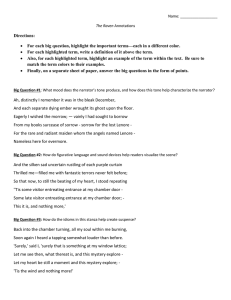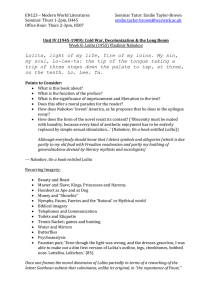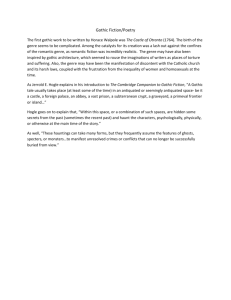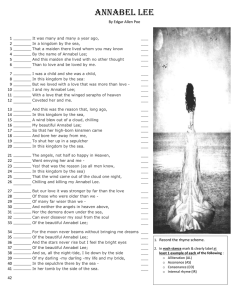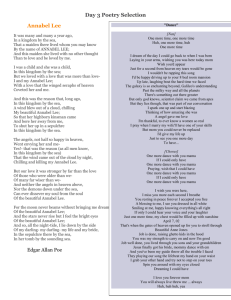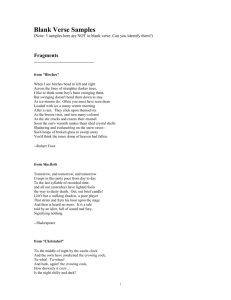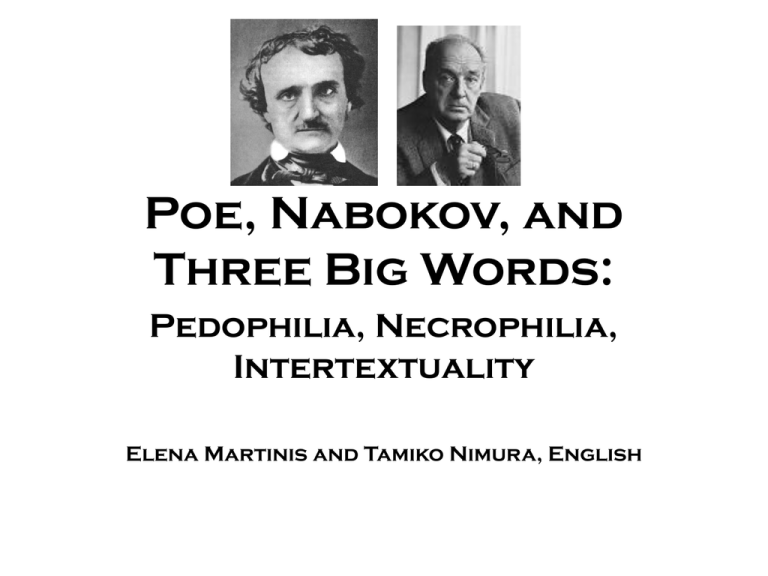
Poe, Nabokov, and
Three Big Words:
Pedophilia, Necrophilia,
Intertextuality
Elena Martinis and Tamiko Nimura, English
Intertextuality:
here, “a conversation between
two literary texts”
“Annabel Lee”,
Poe
(Necrophilia?)
Intertextuality
Lolita,
Nabokov
(Pedophilia)
“Annabel Lee”
It was many and many a year ago,
In a kingdom by the sea,
That a maiden there lived whom you may know
By the name of Annabel Lee;
And this maiden she lived with no other thought
Than to love and be loved by me.
I was a child and she was a child,
In this kingdom by the sea:
But we loved with a love that was more than love—
I and my Annabel Lee;
With a love that the winged seraphs of heaven
Coveted her and me.
“Annabel Lee”
And this was the reason that, long ago,
In this kingdom by the sea,
A wind blew out of a cloud, chilling
My beautiful Annabel Lee;
So that her highborn kinsmen came
And bore her away from me,
To shut her up in a sepulchre
In this kingdom by the sea.
The angels, not half so happy in heaven,
Went envying her and me—
Yes! that was the reason (as all men know,
In this kingdom by the sea)
That the wind came out of the cloud by night,
Chilling and killing my Annabel Lee.
“Annabel Lee”
But our love it was stronger by far than the love
Of those who were older than we—
Of many far wiser than we—
And neither the angels in heaven above,
Nor the demons down under the sea,
Can ever dissever my soul from the soul
Of the beautiful Annabel Lee:
For the moon never beams, without bringing me dreams
Of the beautiful Annabel Lee;
And the stars never rise, but I feel the bright eyes
Of the beautiful Annabel Lee;
And so, all the night-tide, I lie down by the side
Of my darling—my darling—my life and my bride,
In her sepulcher there by the sea,
In her tomb by the sounding sea.
•
Annabel Lee=Annabel Leigh:
A few Poe allusions in Nabokov
Nabokov almost gave Lolita the title The Kingdom by the Sea.
The narrator (Humbert)’s first love is a child named Annabel Leigh, who dies young.
Poe:
•“The angels, not half so happy in
heaven,/Went envying her and
me—”
•
•
Nabokov:
“exhibit number one is what the
seraphs…envied” (9)
•“I was a child and she was a
child/In this kingdom by the
sea:/But we loved with a love that
was more than love—/I and my
Annabel Lee;”
•
“When I was a child and she was a
child…We loved each other with a
premature love, marked by a
fierceness that so often destroys
adult lives” (16-7)
•
“I shall probably have another
breakdown if I stay any longer in
this house, under the strain of this
intolerable temptation, by the side
of my darling—my darling—my life
and my bride” (47)
Poe and Necrophilia
• Biographical reading: “Annabel Lee” is
thought by some biographers to be dedicated
to Poe’s “child bride” (who was 13, and died
young)
• Textual reading: The imagery in the final
stanza could be interpreted as necrophilic:
“And so, all the night-tide, I lie down by the
side/Of my darling--my darling--my life and
my bride…”
Necrophilia:
The Poetic
and
the Perverse
“a morbid obsession such as
necrophilia can be a useful, flexible
metaphor for complex psychological
patterns of desire which are not
necessarily pathological, or even
perverse.”
–Lucy Maddox, “Necrophilia in Lolita”
Necrophilia in Popular Culture
“Annabel Lee”
www.gutenberg.org
Walt Disney’s Sleeping Beauty
allvintagestore.com
History and Studies of Necrophilia
Ancient Egyptians
Studies of Necrophilia
• Richard von Kraft-Ebing (1886)
• Johnathan P. Rosman and
Phillip J. Resnick (1989)
King Herod
http://www.notablebiographies.com/images/uewb_05
_img0337.jpg
Rosman and Resnick
Genuine
Necrophile
Has a persistent
attraction to corpses
Pseudonecrophile:
Has a transient attraction
to corpses, but corpses
are not the object
of his sexual fantasies
Necrophilic
Homicide
Regular
Necrophilia
Necrophilic
Fantasy
Murder to obtain corpse
for sexual purposes
Use of already dead
bodies for sexual pleasure
Fantasizing about Sexual
activity with a corpse
Pedophilia and Necrophilia
Paraphilia:
Deviant sexual behavior
Pedophilia:
Necrophilia:
The fantasy or act of sexual activity
with prepubescent children
A sexual attraction to corpses
Necrophilia: Lack of Self-Esteem
• “The passion I had developed for that nymphet- for the first nymphet
in my life that could be reached by my awkward, aching, timid
claws- would have certainly landed me again in a sanitorium . . .”
(Humbert, 56, Italics mine)
• “I had ceased to be Humbert the Hound, the sad-eyed degenerate
cur clasping the boot that would presently kick him away. I was
above the tribulations of ridicule, beyond the possibilities of
retribution.” (Humbert, 60, Italics mine)
Motives for Necrophilia
Examples of Motives in Lolita:
Motives Cited by Rosman and Resnick:
Reunion with a romantic partner
•
Attempt to gain comfort / overcome feelings of
isolation
•
Conscious sexual attraction to corpses
•
Attempt to gain self-esteem / total control
•
Fusion of aggressive and libidinal drives
•
An attempt to deal with loss or the fear of loss
Identification with the mother. Attempt to
deal with separation anxieties
“I broke her spell by incarnating her in
another.” (Humbert, 15)
“My very photogenic mother died in a
freak accident (picnic, lightning) when I
was three” (Humbert, 10)
Humbert: Metaphorical Necrophile
•
“I wish this memoir to be published only when Lolita is no longer alive.”
(Humbert, 309)
•
“What I had madly possessed was not she, but my own creation, another,
fanciful Lolita- perhaps, more real than Lolita . . . floating between me and
her, and having no will, no consciousness- indeed,
no life of her own.” (Humbert, 62)
•
“it was always my habit and method to ignore Lolita’s states of mind while
comforting my own base self.” (Humbert, 287)
•
“she would be dead in his arms.” (Humbert, 116)
•
“It was something quite special, that feeling: an oppressive, hideous
constraint as if I were sitting with the small ghost of somebody I had just
killed.” (Humbert, 140)
Sources
Bronfen, Elisabeth. Over her Dead Body: Death, Femininity and the aesthetic. New York: Routledge, 1992.
Burg, B.R. “The Sick and the Dead: The Development of Psychological Theory on
Necrophilia from Kraft-Ebing to the Present.” Journal of the History of the
Behavioral Sciences 18 (1982): 242-254.
Coviello, Peter. “Poe in Love: Pedophilia, Morbidity, and the Logic of Slavery.” ELH 70
(2003): 875-901.
Kennedy, Gerald J. Poe, Death, and the Life of Writing. New Haven: Yale University Press, 1987.
Maddox, Lucy. “Necrophilia in Lolita.” In Harold Bloom ed., Lolita (New York: Chelsea House, 1993), pp. 79-89.
Nabokov, Vladimir. The Annotated Lolita. New York: Vintage Books, 1991. Ed. Alfred Apple.
Proffer, Carl R. Keys to Lolita. London: Indiana University Press, 1968.
Rosman, Johnathan P. and Philip J. Resnick. “Sexual Attraction to Corpses: A Psychiatric Review of Necrophilia.”
Bulletin of the American Academy of Psychiatry and the Law 17 (1989): 153-163.
Intertextuality: what does it
mean here?
“Annabel Lee”,
Poe
(Necrophilia)
Intertextuality
Lolita,
Nabokov
(Pedophilia)

